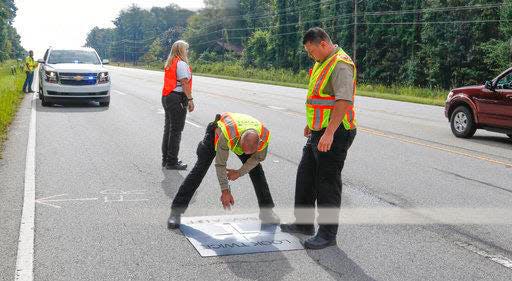NHTSA wants voluntary commitment on new braking rules from automakers

Federal traffic safety regulators have proposed a major rule change for automakers related to braking that they say could save as many as 360 lives every year and reduce the number of injuries in crashes by at least 24,000 annually.
It’s specifically aimed at reducing the perplexingly high number of pedestrian fatalities in recent years, a problem that Ann Carlson, chief counsel for the National Highway Traffic Safety Administration, called a “really dark spot” in traffic fatalities. A Free Press investigation, "Death on Foot," also spotlighted the issue.
Carlson noted that pedestrian fatalities have increased 53% in 10 years; NHTSA earlier estimated that almost 43,000 people died in motor vehicle crashes in 2021, a 10.5% increase.
“With this proposal, we could change a high-speed crash from a deadly one to a lower speed crash with minor injuries or just property damage,” Carlson said Wednesday during a news conference.
More: Death on foot: America's love of SUVs is killing pedestrians
The proposal would shift a voluntary commitment by automakers in 2016 to install automatic emergency braking systems on passenger vehicles to a requirement, but one that even NHTSA acknowledged would be a tough standard to meet.
Carlson said that about 90% of new light vehicles now have AEB systems and that the technology is “mature enough” to be proposed for all vehicles. The proposal, however, envisions full collision avoidance at certain speeds, meaning a vehicle would have to stop without touching another vehicle in front of it.
More: Safety advocates push feds, automakers to do more to prevent hot car deaths
Vehicles would need to fully avoid another vehicle in a collision at speeds up to 50 mph when a driver fails to react or up to 62 mph if a driver engages the brake but without enough force to avoid a crash, Carlson said.
“The test is very tough to meet and the reason it’s tough to meet is to eliminate as many collisions as possible,” Carlson said.
As for pedestrians, who are typically killed in crashes at vehicle speeds of 45 mph, the rule would require all cars to be able to stop and avoid them at speeds up to 37 mph, Carlson said.
More: US traffic deaths fell in 1st 9 months of 2022 but pedestrian, cyclist deaths rise
If the rule is adopted, nearly all U.S. light vehicles would be required to have automatic emergency braking technology three years after the publication of a final rule, NHTSA said.
David Harkey, president of the Insurance Institute for Highway Safety and the Highway Loss Data Institute, cheered the proposal, including a provision that would require the technology to work at night, a particular challenge for many systems.
“Pedestrian AEB that works well at night is a game changer for protecting the most vulnerable people on the road,” Harkey said in a statement. “This proven technology takes action when a driver doesn’t and can reduce the severity of a collision or prevent the collision from happening altogether.”
William Wallace, Consumer Reports’ associate director of safety policy, said the proposal would mark a significant improvement in traffic safety.
"This strong rule would save lives, prevent costly crashes, and dramatically raise the bar for safety on our roads. It’s desperately needed at a time when more than 100 people in the U.S. die in vehicle crashes every single day. This has been a long time coming, and auto safety advocates have been calling for this for years — but this proposal meets the moment,” Wallace said in a statement.
The Detroit Free Press reached out to various automakers, including Ford, General Motors and Chrysler- and Jeep-parent Stellantis, for comment as well.
The Alliance for Automotive Innovation, an industry group representing numerous automakers, released a statement through spokeswoman Tonya Parish, saying that "automakers have already developed and deployed automatic emergency braking (AEB) safety technology to help detect imminent vehicle collisions, warn the driver and automatically apply the brakes." It called AEB a "breakthrough safety technology that uses radar, cameras and lasers to prevent crashes and save lives that the industry voluntarily committed to install in nearly all new vehicles by 2025."
The group noted that several automakers are ahead of schedule on the voluntary commitment.
GM, through spokesman Stuart Fowle, declined to comment on the proposal, noting that it's under review.
However, he noted that "in terms of our commitment, we are on track to surpass the voluntary program including 100% of 2023 electric vehicles and 98% of all GM models by the end of the 2023 model year. For the 2024 model year, our (Heavy Duty) trucks will receive standard AEB as well."
He also referenced a GM news release that said four additional active safety features would be standard on the majority of 2023 model year vehicles: Forward Collision Alert, Front Pedestrian Braking, Lane Keep Assist with Lane Departure Warning and IntelliBeam auto high-beam control.
Ford spokeswoman Melissa Miller provided a statement, saying ”while we’re still reviewing the proposed rulemaking, Ford fully supports automatic emergency braking as an important safety feature for our customers; it’s already present on 96% of our cars, trucks and SUVs.”
Stellantis indicated it's reviewing the proposal.
Free Press staff writers Jamie L. LaReau and Phoebe Wall Howard contributed to this report.
Contact Eric D. Lawrence: elawrence@freepress.com. Become a subscriber.
This article originally appeared on Detroit Free Press: NHTSA says new rule for automakers would save hundreds of lives a year
